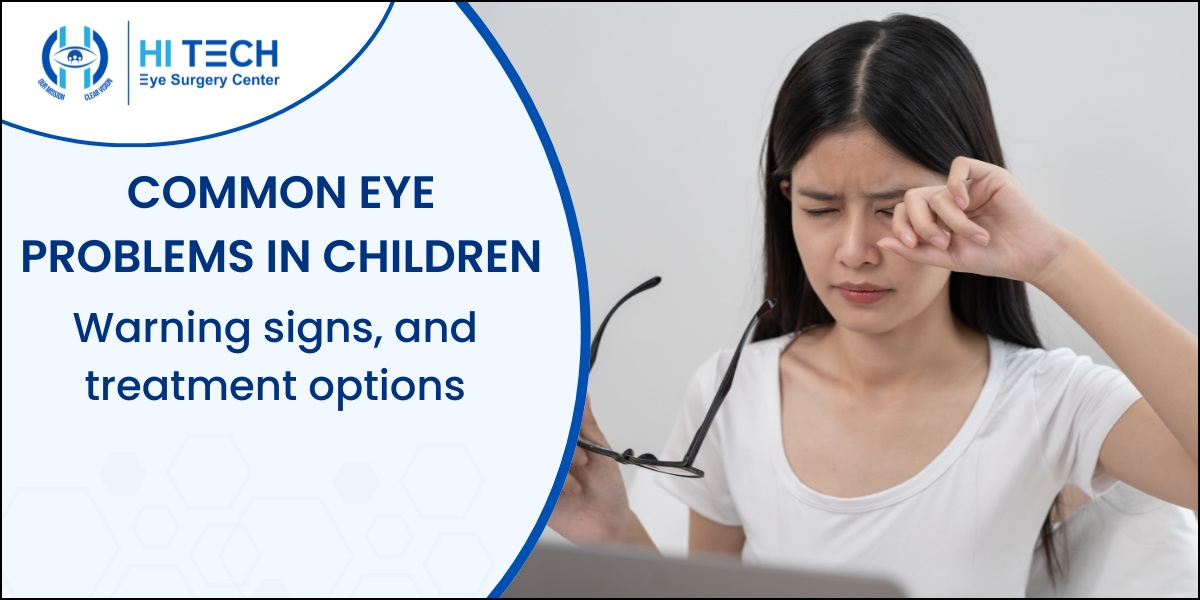Common Eye Problems in Children
Good vision plays a vital role in a child’s learning and overall development. From reading books to playing sports, healthy eyesight helps children explore the world around them with confidence. However, many children face vision problems at an early age, which often go unnoticed by parents. Identifying eye issues early can prevent long-term complications and support better academic and social growth.
Most common eye problems in children – Warning signs and treatment options
1. Refractive Errors (Glasses Number Issues)
If your child prefers sitting very close to the TV, holds books too near, or frequently complains of headaches, they may have nearsightedness, farsightedness, or astigmatism. A simple pair of glasses can make a world of difference in how they see and learn.
2. Lazy Eye (Amblyopia)
Imagine one eye doing all the work while the other “switches off.” This condition is called amblyopia. Kids may not even realize it, but if left untreated, the weaker eye can lose vision permanently. Early treatment with glasses, eye patching, or exercises can help restore balance.
3. Squint (Crossed or Misaligned Eyes)
Sometimes you may notice your child’s eye drifting inward, outward, or upward. This is more than just a cosmetic issue — it can affect depth perception and learning. The good news is that with timely treatment (glasses, therapy, or surgery), children can develop straight, healthy vision.
4. Allergic Eye Problems
Red, itchy, watery eyes that keep your child rubbing constantly could be a sign of eye allergies. Seasonal changes, dust, or pets may trigger it. Simple lifestyle changes and medications usually help keep it under control.
5. Blocked Tear Ducts (in Babies)
If your infant’s eyes are always watery or sticky, it may be due to a blocked tear duct. Many cases resolve on their own with gentle massage, but sometimes treatment is needed.
Why Early Check-Ups Matter
Children often adapt to vision problems without realizing it. A child struggling to see the blackboard, having trouble reading, or avoiding sports may simply need an eye check-up. Experts recommend a detailed eye exam by the age of 3–4 years, or earlier if parents notice any eye turning, frequent rubbing, or unusual behavior.
At Hi Tech Eye Surgery Centre, our pediatric eye specialists provide gentle, child-friendly care to detect and treat these problems early. Because clear vision today means a brighter tomorrow for your child.
FAQs About Common Eye Problems in Children
1. At what age should my child have their first eye check-up?
It is recommended that children have a detailed eye exam by the age of 3–4 years, or earlier if parents notice signs like frequent eye rubbing, squinting, sitting too close to the TV, or one eye turning inward or outward.
2. How can I tell if my child needs glasses?
Signs include sitting too close to screens, holding books very close, complaining of headaches, poor performance at school, or avoiding sports. An eye test by a specialist is the best way to confirm.
3. Is a squint (crossed eyes) just a cosmetic issue?
No. A squint can affect depth perception, coordination, and vision development. Early treatment with glasses, therapy, or surgery can help align the eyes and improve vision.
4. Will my child outgrow lazy eye (amblyopia) naturally?
No. Lazy eye does not improve on its own. It needs early treatment with glasses, patching, or exercises. The earlier it’s detected, the better the chances of full recovery.
5. My baby’s eyes are always watery. Should I be worried?
Persistent watery or sticky eyes in babies may indicate a blocked tear duct. Many cases improve with gentle massage, but if it continues, consult a pediatric eye specialist for proper care.


